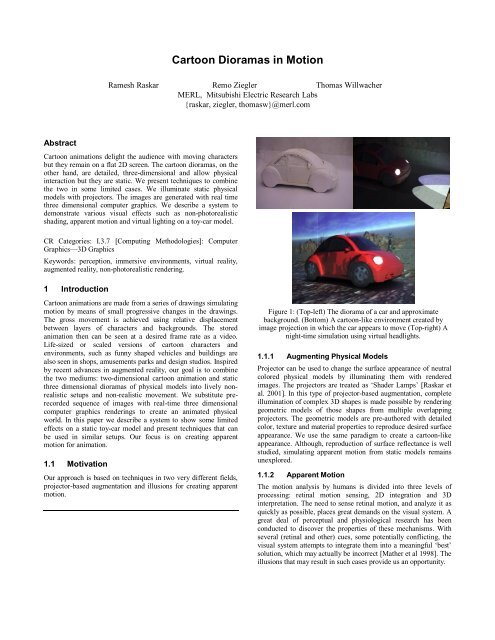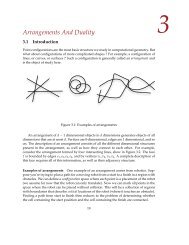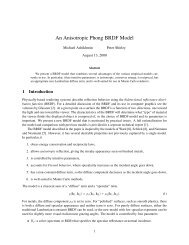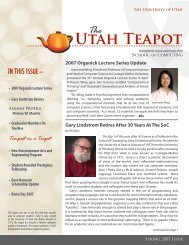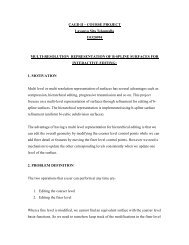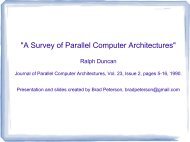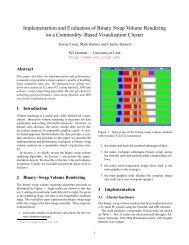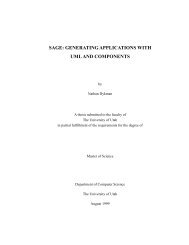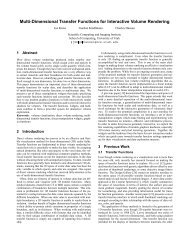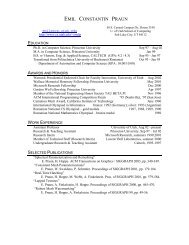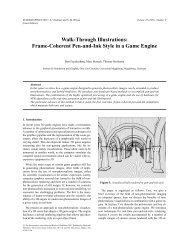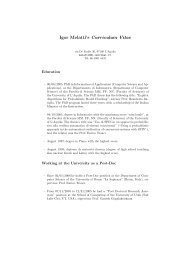Cartoon Dioramas in Motion - CiteSeerX
Cartoon Dioramas in Motion - CiteSeerX
Cartoon Dioramas in Motion - CiteSeerX
You also want an ePaper? Increase the reach of your titles
YUMPU automatically turns print PDFs into web optimized ePapers that Google loves.
Abstract<br />
<strong>Cartoon</strong> <strong>Dioramas</strong> <strong>in</strong> <strong>Motion</strong><br />
Ramesh Raskar Remo Ziegler Thomas Willwacher<br />
MERL, Mitsubishi Electric Research Labs<br />
{raskar, ziegler, thomasw}@merl.com<br />
<strong>Cartoon</strong> animations delight the audience with mov<strong>in</strong>g characters<br />
but they rema<strong>in</strong> on a flat 2D screen. The cartoon dioramas, on the<br />
other hand, are detailed, three-dimensional and allow physical<br />
<strong>in</strong>teraction but they are static. We present techniques to comb<strong>in</strong>e<br />
the two <strong>in</strong> some limited cases. We illum<strong>in</strong>ate static physical<br />
models with projectors. The images are generated with real time<br />
three dimensional computer graphics. We describe a system to<br />
demonstrate various visual effects such as non-photorealistic<br />
shad<strong>in</strong>g, apparent motion and virtual light<strong>in</strong>g on a toy-car model.<br />
CR Categories: I.3.7 [Comput<strong>in</strong>g Methodologies]: Computer<br />
Graphics—3D Graphics<br />
Keywords: perception, immersive environments, virtual reality,<br />
augmented reality, non-photorealistic render<strong>in</strong>g.<br />
1 Introduction<br />
<strong>Cartoon</strong> animations are made from a series of draw<strong>in</strong>gs simulat<strong>in</strong>g<br />
motion by means of small progressive changes <strong>in</strong> the draw<strong>in</strong>gs.<br />
The gross movement is achieved us<strong>in</strong>g relative displacement<br />
between layers of characters and backgrounds. The stored<br />
animation then can be seen at a desired frame rate as a video.<br />
Life-sized or scaled versions of cartoon characters and<br />
environments, such as funny shaped vehicles and build<strong>in</strong>gs are<br />
also seen <strong>in</strong> shops, amusements parks and design studios. Inspired<br />
by recent advances <strong>in</strong> augmented reality, our goal is to comb<strong>in</strong>e<br />
the two mediums: two-dimensional cartoon animation and static<br />
three dimensional dioramas of physical models <strong>in</strong>to lively nonrealistic<br />
setups and non-realistic movement. We substitute prerecorded<br />
sequence of images with real-time three dimensional<br />
computer graphics render<strong>in</strong>gs to create an animated physical<br />
world. In this paper we describe a system to show some limited<br />
effects on a static toy-car model and present techniques that can<br />
be used <strong>in</strong> similar setups. Our focus is on creat<strong>in</strong>g apparent<br />
motion for animation.<br />
1.1 Motivation<br />
Our approach is based on techniques <strong>in</strong> two very different fields,<br />
projector-based augmentation and illusions for creat<strong>in</strong>g apparent<br />
motion.<br />
Figure 1: (Top-left) The diorama of a car and approximate<br />
background. (Bottom) A cartoon-like environment created by<br />
image projection <strong>in</strong> which the car appears to move (Top-right) A<br />
night-time simulation us<strong>in</strong>g virtual headlights.<br />
1.1.1 Augment<strong>in</strong>g Physical Models<br />
Projector can be used to change the surface appearance of neutral<br />
colored physical models by illum<strong>in</strong>at<strong>in</strong>g them with rendered<br />
images. The projectors are treated as ‘Shader Lamps’ [Raskar et<br />
al. 2001]. In this type of projector-based augmentation, complete<br />
illum<strong>in</strong>ation of complex 3D shapes is made possible by render<strong>in</strong>g<br />
geometric models of those shapes from multiple overlapp<strong>in</strong>g<br />
projectors. The geometric models are pre-authored with detailed<br />
color, texture and material properties to reproduce desired surface<br />
appearance. We use the same paradigm to create a cartoon-like<br />
appearance. Although, reproduction of surface reflectance is well<br />
studied, simulat<strong>in</strong>g apparent motion from static models rema<strong>in</strong>s<br />
unexplored.<br />
1.1.2 Apparent <strong>Motion</strong><br />
The motion analysis by humans is divided <strong>in</strong>to three levels of<br />
process<strong>in</strong>g: ret<strong>in</strong>al motion sens<strong>in</strong>g, 2D <strong>in</strong>tegration and 3D<br />
<strong>in</strong>terpretation. The need to sense ret<strong>in</strong>al motion, and analyze it as<br />
quickly as possible, places great demands on the visual system. A<br />
great deal of perceptual and physiological research has been<br />
conducted to discover the properties of these mechanisms. With<br />
several (ret<strong>in</strong>al and other) cues, some potentially conflict<strong>in</strong>g, the<br />
visual system attempts to <strong>in</strong>tegrate them <strong>in</strong>to a mean<strong>in</strong>gful ‘best’<br />
solution, which may actually be <strong>in</strong>correct [Mather et al 1998]. The<br />
illusions that may result <strong>in</strong> such cases provide us an opportunity.
We are specifically <strong>in</strong>terested <strong>in</strong> exploit<strong>in</strong>g the perception of<br />
motion when there is no correspond<strong>in</strong>g physical displacement <strong>in</strong><br />
space. This perception of motion is known as apparent motion<br />
[Smith and Snowden 1994]. There are four well-known types of<br />
apparent motion: motion after effect (MAE) (e.g. upward motion<br />
of objects near a waterfall), phi phenomenon (e.g. filled <strong>in</strong> motion<br />
<strong>in</strong> a movie of flicker<strong>in</strong>g animation stills) , <strong>in</strong>duced motion (e.g.<br />
perceived movement due to a slowly mov<strong>in</strong>g tra<strong>in</strong> on the next<br />
track) and autok<strong>in</strong>etic movement (e.g. perturbation seen at small<br />
light <strong>in</strong> a dark room). In addition, one type of physical motion<br />
may result <strong>in</strong> some other types of apparent motion due to either<br />
2D <strong>in</strong>tegration or 3D <strong>in</strong>terpretation error. A good example is<br />
mov<strong>in</strong>g shadows which act as a strong cue to depth change.<br />
Us<strong>in</strong>g 3D computer graphics, <strong>in</strong> this paper, we ma<strong>in</strong>ly exploit the<br />
<strong>in</strong>duced motion effect and the 3D <strong>in</strong>terpretation error for some<br />
very constra<strong>in</strong>ed cases. To <strong>in</strong>duce motion, we segment a<br />
cont<strong>in</strong>uous static physical scene <strong>in</strong>to sub-parts. We then<br />
illum<strong>in</strong>ate each sub-part with rendered animations so that the<br />
multiple movements appear compatible. We also force temporary<br />
and <strong>in</strong>valid 3D <strong>in</strong>terpretation us<strong>in</strong>g shadows, light<strong>in</strong>g and texture<br />
movements.<br />
<strong>Motion</strong> perception is, however, a complex topic. New models <strong>in</strong><br />
understand<strong>in</strong>g apparent motion are still evolv<strong>in</strong>g. There may be<br />
many other ways of us<strong>in</strong>g the errors <strong>in</strong> human motion analysis.<br />
1.2 Previous Work<br />
In cartoon and <strong>in</strong> live action films, characters are made to appear<br />
<strong>in</strong> motion relative to the background by mov<strong>in</strong>g the background <strong>in</strong><br />
the opposite direction. However, there are surpris<strong>in</strong>gly few efforts<br />
at generat<strong>in</strong>g apparent and susta<strong>in</strong>ed motion <strong>in</strong> the real world. A<br />
well-known example is the s<strong>in</strong>g<strong>in</strong>g heads at Disney’s “Haunted<br />
Mansion” [Liljegren 1990]. Pre-recorded video, synchronized<br />
with sound, is projected on semi-transparent busts of men to<br />
create a compell<strong>in</strong>g effect that the busts are chang<strong>in</strong>g shapes<br />
correspond<strong>in</strong>g to facial expressions.<br />
Based on the underly<strong>in</strong>g complexity, the previous work <strong>in</strong> us<strong>in</strong>g<br />
projectors for augmented reality can be divided <strong>in</strong>to two ma<strong>in</strong><br />
groups (i) projection of useful <strong>in</strong>formation on a planar surface,<br />
and (ii) more complex <strong>in</strong>sertion of 3D shapes and attributes <strong>in</strong>to<br />
the real world. There are several examples of 2D augmentation -<br />
<strong>in</strong>teractive 2D images projected on flat surfaces <strong>in</strong> a room to<br />
enhance the user’s environment, Lum<strong>in</strong>ous room [UnderKoffler et<br />
al 1997], digital desk [Wellner 1993], and smart whiteboards.<br />
The 3D augmentation examples are fewer, Shader Lamps [Raskar<br />
et al. 2001][Bandyopadhyay et al. 2001] and the related project<br />
Be<strong>in</strong>g There [Low et al. 2001].<br />
1.3 Contribution<br />
Our ma<strong>in</strong> contribution is a general set of techniques to allow a<br />
limited comb<strong>in</strong>ation of non-photorealistic images with physical<br />
models to generate non-realistic appearance and movement. We<br />
demonstrate the ideas <strong>in</strong> the context of a system, discuss methods<br />
to make them practical and describe user experiences. We hope<br />
to contribute to the body of research <strong>in</strong> immersive non-realistic<br />
animation and spatially augmented reality.<br />
2 Effects<br />
In this paper, our demonstration system <strong>in</strong>cludes augmentation of<br />
a diorama made up of a toy-car model and its surround<strong>in</strong>gs. In<br />
that context, we discuss and describe new render<strong>in</strong>g techniques<br />
that take <strong>in</strong>to account the relationships between the user position,<br />
real objects, virtual objects, light projectors and the surface<br />
attributes of the virtual objects. The techniques can also be<br />
applied to other types of dioramas.<br />
There are effectively two steps: augment<strong>in</strong>g objects so that they<br />
have cartoon appearance and simulat<strong>in</strong>g apparent motion.<br />
2.1 Spatial Augmentation<br />
Many physical attributes can be effectively <strong>in</strong>corporated <strong>in</strong>to the<br />
light source to achieve a perceptually equivalent effect on a<br />
neutral object. While the results are theoretically equivalent for<br />
only a limited class of surfaces and attributes, our experience is<br />
that they are quite conv<strong>in</strong>c<strong>in</strong>g and compell<strong>in</strong>g for a broad range of<br />
applications. The task is easier when a non-realistic appearance is<br />
desired. This subsection describes a technique very similar to the<br />
one used <strong>in</strong> [Raskar et al. 01]. The approach for a general<br />
projector-based augmentation system is summarized below.<br />
Dur<strong>in</strong>g pre-process<strong>in</strong>g<br />
Create 3D graphics model, G, of physical object<br />
Create 3D graphics model, B, of background<br />
Approximately position the projector<br />
F<strong>in</strong>d perspective pose, P, of the projector wrt the physical object<br />
Dur<strong>in</strong>g run-time<br />
Get user location, U<br />
Get animation transformation, T<br />
Modify G’s surface attributes<br />
Render G us<strong>in</strong>g the pose P, and user location U<br />
Transform B us<strong>in</strong>g T -1 , B’<br />
Render B’ us<strong>in</strong>g the pose P, and user location U<br />
Modify image <strong>in</strong>tensity to compensate for surface orientation<br />
To reproduce purely view-<strong>in</strong>dependent surface appearance<br />
(diffuse reflectance), user location is not required. For viewdependent<br />
effects such as specular highlights, approximate user<br />
location is necessary. The user’s location, U, can be tracked us<strong>in</strong>g<br />
magnetic or optical track<strong>in</strong>g technology. In our case, we assume<br />
the user is at a sweet-spot stand<strong>in</strong>g <strong>in</strong> front of the car and do not<br />
track the user.<br />
The projector projection matrix, P, is obta<strong>in</strong>ed us<strong>in</strong>g an off-l<strong>in</strong>e<br />
calibration process similar to the technique used for f<strong>in</strong>d<strong>in</strong>g<br />
<strong>in</strong>ternal and external parameters of a camera [Faugeras 1993]. We<br />
take a set of fiducials with known 3D locations on the physical<br />
object and f<strong>in</strong>d the correspond<strong>in</strong>g projector pixels that illum<strong>in</strong>ate<br />
them. This allows us to compute a 3x4 perspective projection<br />
matrix, up to scale, which is decomposed to f<strong>in</strong>d the <strong>in</strong>ternal and<br />
the external parameters of the projector. The <strong>in</strong>ternal parameters<br />
represent the focal length and pr<strong>in</strong>cipal po<strong>in</strong>t, while the external<br />
parameters represent the rigid transformation (translation and<br />
rotation) with respect to the coord<strong>in</strong>ate system of the physical<br />
object. The render<strong>in</strong>g process uses the same <strong>in</strong>ternal and external<br />
parameters to render the pre-authored geometric model, G, so that<br />
the projected images are registered with the physical objects.<br />
Dur<strong>in</strong>g run-time, <strong>in</strong>stead of the object, G, the background, B, is<br />
transformed to create the apparent motion. At each frame, an<br />
<strong>in</strong>tensity correction stage pre-multiplies the projected image with<br />
<strong>in</strong>tensity weights to compensate for the local surface orientation.<br />
Otherwise, surfaces normal to the <strong>in</strong>cident light will appear
Ground<br />
Backdrop<br />
(i) Perceived horizontal forward<br />
motion, background texture<br />
moves backward, wheels rotate<br />
clockwise<br />
(iii) Bumpy movement on a<br />
rough surface<br />
brighter than surfaces illum<strong>in</strong>ated obliquely due to the cos<strong>in</strong>e falloff.<br />
2.2 <strong>Cartoon</strong> Shad<strong>in</strong>g<br />
(ii) Wavy motion due to wheels<br />
which are non-circular but<br />
attached to the car (up-down<br />
motion)<br />
(iv) Shear dur<strong>in</strong>g acceleration<br />
Figure 2: Types of apparent motion for a car. Rendered motion is<br />
shown with blue arrow. The resultant apparent motion is shown<br />
with dashed blue arrow.<br />
Our focus is ma<strong>in</strong>ly creat<strong>in</strong>g cartoon-like (apparent) movements.<br />
To enhance the cartoon-feel, however, we implemented wellknown<br />
non-photorealistic shad<strong>in</strong>g techniques with some<br />
modifications. The scene is made up of a toy-car model, with a<br />
simple background of a horizontal and a vertical surface. The<br />
horizontal surface coarsely represents the ground surface, either a<br />
road or rough terra<strong>in</strong>. The vertical surface is the backdrop which<br />
represents everyth<strong>in</strong>g else <strong>in</strong>clud<strong>in</strong>g bushes, trees and sky. To<br />
improve the visual fidelity, the background can be made<br />
arbitrarily complex as long it has a constant profile along any<br />
plane perpendicular to the direction of apparent motion..<br />
We use the technique proposed by [Lake et al. 2000] to render a<br />
flat-shaded look. As described below, we modify the color<br />
quantization procedure to take <strong>in</strong>to account the cut-off angle of<br />
the spot-beams for street lights. For static scenes, we also<br />
highlight sharp edges as seen <strong>in</strong> the traditional 2D cartoon<br />
animation stills [Raskar 2001]. However, we realized that for<br />
objects with apparent motion, the sharp features are distract<strong>in</strong>g<br />
because they work aga<strong>in</strong>st the notion of motion blur. For dynamic<br />
three dimensional scenes, human visual system segments scenes<br />
based on group<strong>in</strong>g of objects <strong>in</strong> motion [Mather 1998]. Hence, we<br />
speculate that, <strong>in</strong> the ret<strong>in</strong>al image, the boundaries between<br />
regions with different optical flow are more important than edges<br />
correspond<strong>in</strong>g to discont<strong>in</strong>uity <strong>in</strong> surface normal (i.e. sharp<br />
features). However, this aspect needs more <strong>in</strong>vestigation. Edges<br />
correspond<strong>in</strong>g to discont<strong>in</strong>uity <strong>in</strong> depth (i.e. silhouettes) are<br />
generally a subset of the boundaries between regions with<br />
different directions or rates of optical flow.<br />
Figure 3: Vertical displacement by shift<strong>in</strong>g the background and<br />
shadows. These two pictures are taken from the same camera<br />
position, so the car <strong>in</strong> both images is at the same location. Note (i)<br />
the change <strong>in</strong> position of the virtual shadows and (ii) the parallax<br />
for the edge between ground and backdrop with respect to the<br />
right headlight.<br />
2.3 <strong>Motion</strong> Effects<br />
The car is simulated as driv<strong>in</strong>g along a road, on a rough surface,<br />
or <strong>in</strong> various other environments. To create apparent motion, we<br />
illum<strong>in</strong>ate wheels with images of rotat<strong>in</strong>g wheels. The images of<br />
the background (made up of the backdrop and ground) move <strong>in</strong> a<br />
direction opposite to the <strong>in</strong>tended car movement. In the simplest<br />
case, as seen <strong>in</strong> the video, the car appears to move forward i.e. left<br />
to right. To create this effect, the wheels rotate clockwise and the<br />
background moves right to left (Figure 2(i)). The crucial task for a<br />
believable movement is ma<strong>in</strong>ta<strong>in</strong><strong>in</strong>g consistency between the<br />
angular wheel movement and correspond<strong>in</strong>g translation of the<br />
ground (and the backdrop). For any duration,<br />
∫ (wheel perimeter arc length) = | displacement of the bkgrnd |<br />
This ensures that the wheels are not slid<strong>in</strong>g while the car is <strong>in</strong><br />
motion. A small amount of motion blur is added to the wheels.<br />
Along the direction of the motion, the background geometry with<br />
the associated texture maps is <strong>in</strong>f<strong>in</strong>itely long, and is implemented<br />
us<strong>in</strong>g a simple s<strong>in</strong>k and a source.<br />
We experimented with many types of cartoon or non-realistic<br />
motions. Two additional factors that add to the effect are sound<br />
and removal of (physical) sharp edges <strong>in</strong> the background.<br />
2.3.1 Wobbly <strong>Motion</strong><br />
Slow mov<strong>in</strong>g cartoon cars usually have a wavy or bumpy<br />
movement result<strong>in</strong>g <strong>in</strong> a small periodic or random displacement<br />
along the vertical direction. This sometimes is emphasized by<br />
non-circular wheels. In our case, the car is static. Hence, to create<br />
the desired apparent vertical shift while the car is <strong>in</strong> motion, we<br />
<strong>in</strong>stead translate the background <strong>in</strong> the opposite (vertical)<br />
direction (Figure 3). Dur<strong>in</strong>g render<strong>in</strong>g, the 3D geometric model<br />
of the backdrop as well as the ground is translated vertically. The<br />
amount of translation, <strong>in</strong> the case of non-circular wheels, is<br />
determ<strong>in</strong>ed by distance between the po<strong>in</strong>t of contact of the wheels<br />
from wheel axis (Figure 2(ii)). The distance traveled is aga<strong>in</strong><br />
consistent with <strong>in</strong>tegration of the arc length of wheel perimeter.<br />
We encourage the reader to watch the accompany<strong>in</strong>g video to<br />
view both types of motions. (The video gives a good idea of the<br />
effect of the transitions, but it is stronger when experienced <strong>in</strong><br />
person with all the three dimensional cues. Please see the<br />
subsection on user reactions.)<br />
It is important to note that to create apparent motion, sometimes,<br />
the underly<strong>in</strong>g physical geometry does not match up with the<br />
virtual model. For example, with vertical displacement, the<br />
boundary between vertical and horizontal surface (shown as
Figure 4: Shad<strong>in</strong>g due to street lights as spot lights.<br />
brown sharp edge <strong>in</strong> Figure 2(i)) does not correspond to the<br />
projection of the boundary between the backdrop and ground.<br />
Hence, first we need to elim<strong>in</strong>ate any sharp edges that the user<br />
may be able to use as a frame of reference. A conflict<strong>in</strong>g cue<br />
affects the perception of vertical component of the motion.<br />
Second, we need to represent the surface with the approximate<br />
average of correspond<strong>in</strong>g variation <strong>in</strong> the geometry. The solution<br />
is to the smooth the edge us<strong>in</strong>g a paper with small curvature (see<br />
brown l<strong>in</strong>es <strong>in</strong> Figure 2(ii), (iii) ).<br />
2.3.2 Lights and Shadows<br />
Shadows provide a very important cue <strong>in</strong> apparent motion<br />
[Kersten et al. 1997]. For example, <strong>in</strong> a two-dimensional image<br />
sequence (i.e. without any other depth cues), a ball mov<strong>in</strong>g<br />
diagonally upwards across the screen can be made to appear as if<br />
it is gradually mov<strong>in</strong>g away from the viewer by render<strong>in</strong>g a<br />
shadow that appears to stay with and under the ball. The cue<br />
overrides contradictory <strong>in</strong>formation regard<strong>in</strong>g the unchang<strong>in</strong>g size<br />
of the ball. The strength of the effect does depend on the<br />
properties of the shadow region. For example, shadows with a<br />
penumbra, and which fall below the object, work best.<br />
Accord<strong>in</strong>g to [Kersten et al. 1997] the existence of the illusion<br />
shows that our perception of the spatial layout of scenes relies on<br />
the assumption that the light source responsible for the shadow is<br />
stationary, so that any motion of the shadow is attributed to the<br />
object cast<strong>in</strong>g it.<br />
We enhance the wobbly motion effect by render<strong>in</strong>g virtual<br />
shadows from directional light source (sun) or local lights (street<br />
lights). The change <strong>in</strong> shadow position creates the illusion that the<br />
change is a result of chang<strong>in</strong>g vertical distance between the car<br />
and the ground. We noticed that, it is not necessary to use the<br />
same light position to calculate shad<strong>in</strong>g and shadows! Further,<br />
perceptually, the movement of virtual shadows (Figure 3) is not<br />
affected by the fixed real shadows of the physical car on the<br />
background.<br />
For night time simulation, the only cues are headlight beams and<br />
shad<strong>in</strong>g due to the street lights. The spread of the parabolic<br />
projection of the headlights and change <strong>in</strong> overlap between the<br />
two beams <strong>in</strong>dicates the vertical shift. The color of the two beams<br />
is <strong>in</strong>tentionally chosen slightly different, so that the lateral shift as<br />
the car moves up and down is clearly seen (Figure 1 and 7). We<br />
also exploit spot lights from the street lights. The basic cartoon<br />
shad<strong>in</strong>g equation is modified to take <strong>in</strong>to consideration the spotcut<br />
off angle (Figure 4).<br />
2.3.3 Acceleration dependent modifications<br />
<strong>Cartoon</strong> animators emphasize acceleration, such as a sudden start<br />
or a screech<strong>in</strong>g halt, by geometric deformation of the object. For<br />
example, a car appears to ‘work hard’ to move forward while<br />
start<strong>in</strong>g when the top of the car is sheared <strong>in</strong> the direction of the<br />
acceleration. Similarly a hard brake and stop is <strong>in</strong>dicated by<br />
shear<strong>in</strong>g the top backwards. S<strong>in</strong>ce we cannot shear the physical<br />
model, we enhance this effect us<strong>in</strong>g two tricks.<br />
First, we implement a shear <strong>in</strong> the background that is opposite of<br />
the shear expected <strong>in</strong> the car (Figure 2(iv)). The shear is along one<br />
dimension, along the vertical axis. Hence, for example, dur<strong>in</strong>g a<br />
sudden start, the background shears backward and the shear at a<br />
po<strong>in</strong>t is proportional to the vertical distance from the center of the<br />
car. The po<strong>in</strong>ts above the vertical center of the car translate<br />
backwards while po<strong>in</strong>ts below translate forward (Figure 5).<br />
Without a loss of generality, lets assume that the car center is at<br />
the orig<strong>in</strong>, the vertical direction is parallel to the z-axis, and the<br />
forward direction is parallel to the x-axis, Then the shear at a<br />
given frame is achieved us<strong>in</strong>g a simple transformation matrix [1,<br />
0, -a, 0; 0, 1, 0, 0; 0, 0, 1, 0; 0, 0, 0, 1]. Where a is proportional to<br />
the acceleration at that frame.<br />
S<strong>in</strong>ce the acceleration is positive dur<strong>in</strong>g start<strong>in</strong>g, negative dur<strong>in</strong>g<br />
brak<strong>in</strong>g, and zero dur<strong>in</strong>g constant speed and velocity, the same<br />
shear equation can be used throughout the animation.<br />
For the second trick, we observe that rapid acceleration also<br />
means relative slide between the ground and the wheels. Hence,<br />
for example, a sudden brake results <strong>in</strong> halt <strong>in</strong> rotation of the<br />
wheels, but the background cont<strong>in</strong>ues to move (Please see the<br />
video).<br />
2.3.4 Tracked Illum<strong>in</strong>ation<br />
We synchronize and update the render<strong>in</strong>g of the objects so that the<br />
surface textures appear glued to the objects even as the objects<br />
move. In this case, as seen <strong>in</strong> the video, we rotate the car (along<br />
with the background) on a turntable. Keep<strong>in</strong>g the virtual light<br />
sources fixed, we see correspond<strong>in</strong>g shad<strong>in</strong>g changes.<br />
2.3.5 Issues<br />
The type of effects possible are obviously limited. For example,<br />
we played with motion blur and motion l<strong>in</strong>es typically seen <strong>in</strong><br />
cartoon animations, but without success. A simple problem is lack<br />
of correspond<strong>in</strong>g physical surface to show motion l<strong>in</strong>es beh<strong>in</strong>d the<br />
car. We also could not br<strong>in</strong>g <strong>in</strong> effects such as fog, smoke or<br />
fumes. Display<strong>in</strong>g fog simply washes out the image on the model.<br />
Dur<strong>in</strong>g the night time simulation, the backdrop, which is supposed<br />
to be at a large depth and hence dark, gets illum<strong>in</strong>ated by the<br />
secondary scatter<strong>in</strong>g of headlight beams.<br />
3 Other Applications<br />
A setup to <strong>in</strong>troduce non-realistic appearance and motion can be<br />
used for many other applications. Some examples are educational<br />
Figure 5: Shear<strong>in</strong>g of the background dur<strong>in</strong>g acceleration.
<strong>in</strong>teractive setups (e.g. physics experiments), science and art<br />
museums, stage drama shows, showroom displays, virtual sets and<br />
physical mock-ups for special effects. We assumed the user to be<br />
at a sweet-spot, but with head-track<strong>in</strong>g many view-dependent<br />
effects can be <strong>in</strong>corporated. They <strong>in</strong>clude simulat<strong>in</strong>g complete<br />
(possibly non-realistic) reflectance properties (BRDF), <strong>in</strong>sert<strong>in</strong>g<br />
animated float<strong>in</strong>g 3D objects close to the physical surface (e.g.<br />
crawl<strong>in</strong>g ants or flow<strong>in</strong>g water) or advanced real-time nonphotorealistic<br />
shad<strong>in</strong>g effects [Praun et al. 2001].<br />
We used a simple turn-table to demonstrate illum<strong>in</strong>ation of a<br />
mov<strong>in</strong>g physical object. This can be extended further <strong>in</strong> many<br />
ways depend<strong>in</strong>g on the degrees of freedom of the movement. For<br />
example, current car motion is mostly uniform. By add<strong>in</strong>g small<br />
and sudden turntable rotations <strong>in</strong> and out of the plane, the car can<br />
be made to appear to be tak<strong>in</strong>g turns around a corner or avoid<strong>in</strong>g a<br />
obstacle <strong>in</strong> the middle of the road.<br />
While there is a grow<strong>in</strong>g body of physiological research and<br />
studies of apparent motion, the work so far is limited to twodimensional<br />
experiments and <strong>in</strong> many cases limited to computer<br />
screen simulations. It will be <strong>in</strong>terest<strong>in</strong>g to use the proposed setup<br />
to study other type of stimulation for the human visual system and<br />
better understand the model of motion analysis.<br />
4 Benefits and limitations<br />
A key benefit of this type of spatial augmentation is that a visually<br />
rich, large field-of-view diorama can be generated with greater<br />
amount of <strong>in</strong>tegration of virtual (surface and motion) attributes<br />
with the real world. Multiple people can enjoy the enhanced<br />
diorama just as <strong>in</strong> the traditional dioramas.<br />
A crucial problem is the dependence on display surface<br />
properties. A light colored diffuse object with smooth geometry is<br />
ideal. It is practically impossible to render vivid images on highly<br />
specular, low reflectance or dark surfaces. The ambient light<strong>in</strong>g as<br />
well as secondary scatter<strong>in</strong>g from diffuse surfaces can also affect<br />
the contrast <strong>in</strong> the images. This limits the applications to<br />
controlled light<strong>in</strong>g environments with restrictions on the type of<br />
objects with which virtual objects will be registered. Shadows can<br />
also be a problem if close human <strong>in</strong>teraction is desired.<br />
5 Implementation and lessons<br />
Currently we use a Mitsubishi X80U LCD projector, 1000 lumen,<br />
1024x768 resolution. The toy-car (Barbie Beetle, bought at a toystore)<br />
is 50cm x 25cm x 20cm (Figure 6). The 3D model is<br />
generated from multiple photographs us<strong>in</strong>g PhotoModelerPro and<br />
then authored <strong>in</strong> 3DSMax. The model is very coarse, 602<br />
triangles. We struggled with creat<strong>in</strong>g smoothly vary<strong>in</strong>g normals<br />
across the car surface, result<strong>in</strong>g <strong>in</strong> shad<strong>in</strong>g artifacts. A better 3D<br />
scann<strong>in</strong>g method should overcome those problems. The<br />
animations are rendered at approx. 15-20 fps. To determ<strong>in</strong>e<br />
projector pose dur<strong>in</strong>g calibration, we used 15 pairs of predeterm<strong>in</strong>ed<br />
3D po<strong>in</strong>ts on the car surface and the correspond<strong>in</strong>g<br />
projector pixels that illum<strong>in</strong>ate them. The projectors pixels are<br />
<strong>in</strong>teractively found by project<strong>in</strong>g a cross-hair and mov<strong>in</strong>g the<br />
mouse till the cross-hair l<strong>in</strong>es up with one of the 3D feature po<strong>in</strong>t.<br />
This process takes only two m<strong>in</strong>utes. The result<strong>in</strong>g re-projection<br />
error is less than one pixel allow<strong>in</strong>g near-perfect static<br />
registration. To f<strong>in</strong>d the axis of rotation of the turn table, a second<br />
set of projector pixels for the same 3D po<strong>in</strong>ts, after angular<br />
displacement, is used.<br />
Figure 6: Setup with a projector and simple diorama.<br />
5.1 Use Reactions<br />
We do not have systematic user experience data but the system<br />
has been seen by over two thousand people. The work<strong>in</strong>g system<br />
has been demonstrated to visitors of the lab, at an art show, dur<strong>in</strong>g<br />
UIST’01 conference, and to dozens of Disney researchers <strong>in</strong><br />
Orlando, Florida. Most users get excited at the follow<strong>in</strong>g stages:<br />
(i) when the car starts, (ii) when the car motion switches to bumpy<br />
motion, (iii) when the car is rotated on the turn table while<br />
ma<strong>in</strong>ta<strong>in</strong><strong>in</strong>g its augmented surface appearance. As mentioned<br />
earlier, the effect is most noticeable dur<strong>in</strong>g any changes <strong>in</strong><br />
apparent motion and it lasts for a short time. The human visual<br />
motion detection system quickly becomes balanced aga<strong>in</strong>. Hence,<br />
it is important to constantly change the motion parameters. The<br />
synchronized car eng<strong>in</strong>e (or brake) sound seems to have a huge<br />
impact, it generates anticipation before the car starts and<br />
re<strong>in</strong>forces the notion of a car movement (as opposed to movement<br />
of the background). We implemented a photo-realistic version as<br />
well as the cartoon-like version (Figure 7). The cartoon-like<br />
version appeals more when the car is <strong>in</strong> motion. Viewers, not<br />
familiar with the technique, are unimpressed to see the static<br />
cartoon version. This is probably because we are all used to<br />
look<strong>in</strong>g at much higher quality cartoon-like setups. But, the<br />
Figure 7: Photo-realistic diorama (left column) vs. cartoon<br />
diorama (right column). Note the headlight beams, specular<br />
appearance and textures.
<strong>in</strong>terest <strong>in</strong>creased when we <strong>in</strong>teractively changed the surface<br />
appearance of the car or the background. Many viewers, even<br />
after expla<strong>in</strong><strong>in</strong>g that we are project<strong>in</strong>g on white surfaces, are very<br />
surprised when the projector light is blocked to show the<br />
underly<strong>in</strong>g dull setup of simple static models. Compar<strong>in</strong>g figure 6<br />
and figure 7, it is surpris<strong>in</strong>g to see the amount of f<strong>in</strong>e detail<br />
possible with purely projected images.<br />
So far, two viewers (both women <strong>in</strong> their 30s) have compla<strong>in</strong>ed of<br />
feel<strong>in</strong>g dizzy (a well known side effect of VR/VE worlds).<br />
Children show a tendency to run and catch the mov<strong>in</strong>g car.<br />
Advanced technical viewers after careful observation sometimes<br />
notice the lack of complete illum<strong>in</strong>ation (because we are us<strong>in</strong>g<br />
only one projector and, for example, shadow of the car on the<br />
backdrop is not filled <strong>in</strong> by multiple projectors). Please view the<br />
video and more images at http://www.shaderlamps.com.<br />
6 Conclusion and Future work<br />
We have presented a system and associated techniques to show<br />
apparent cartoon-like motion on a simple diorama. The techniques<br />
allow only a limited comb<strong>in</strong>ation of rendered animation and static<br />
neutral colored physical objects. But, the proposed methods are<br />
sufficiently general and can be used <strong>in</strong> a variety of applications.<br />
Similar to non-realistic render<strong>in</strong>g, there is an <strong>in</strong>terest<strong>in</strong>g<br />
unexplored area of non-realistic motion simulation. We have<br />
presented some prelim<strong>in</strong>ary ideas and a prototype system. There<br />
are many possible directions for comb<strong>in</strong><strong>in</strong>g apparent motion<br />
effects with real time 3D render<strong>in</strong>g <strong>in</strong> projector-based<br />
augmentation. For example, despite the visually compell<strong>in</strong>g<br />
results, the visual adaptation effect lasts for a short time. How can<br />
we make it last longer ? For most effects, the motion detection<br />
system quickly becomes balanced and the apparent movement<br />
becomes weaker or stops. However, the four-stroke apparent<br />
motion [Mather et al. 1998] is a wonderful illusion where the<br />
motion appears to cont<strong>in</strong>ue forever <strong>in</strong> the same direction. The<br />
animation <strong>in</strong>volves a repeat<strong>in</strong>g cycle of four different frames. e.g.<br />
a car moves forward and then backward, but the backward step is<br />
accompanied by a reversal <strong>in</strong> <strong>in</strong>tensities. The effect is to reverse<br />
the direction of perceived motion, result<strong>in</strong>g <strong>in</strong> forward and then<br />
aga<strong>in</strong> forward motion. Can we achieve similar effects on three<br />
dimensional objects ?<br />
We currently limit effects to static models. However, one can<br />
imag<strong>in</strong>e us<strong>in</strong>g phi phenomenon to create apparently morph<strong>in</strong>g<br />
shapes out of two or more static models. Shape change over time<br />
presents the visual system with a correspondence (match<strong>in</strong>g)<br />
problem. The ‘best’ solution is <strong>in</strong>terpreted based on a few<br />
geometric properties. Thus, successively illum<strong>in</strong>at<strong>in</strong>g different<br />
shapes creates the apparent and smooth <strong>in</strong>terpolat<strong>in</strong>g morph. This<br />
has been explored <strong>in</strong> 2D computer simulations and may be<br />
extended to 3D objects by chang<strong>in</strong>g focus of attention from one<br />
static shape to the next with projected light.<br />
Lastly, our use of synchronized realistic sound was limited to<br />
enhanc<strong>in</strong>g the visual effects. But, as noted recently by [Shams et<br />
al. 2000] sound can create virtual motion perception. It should be<br />
worth explor<strong>in</strong>g the use of realistic or even non-realistic<br />
spatialized sound to further <strong>in</strong>tensify the effects.<br />
Acknowledgements<br />
We would like to thank members of the ShaderLamps project,<br />
Greg Welch, Kok-lim Low and Deepak Bandyopadhyay for<br />
useful discussions.<br />
References<br />
BANDYOPADHYAY D., RASKAR R., FUCHS H. 2001. Dynamic<br />
Shader Lamps: Pa<strong>in</strong>t<strong>in</strong>g on Movable Objects. In Proceed<strong>in</strong>gs of<br />
Int. Symp. On Augmented Reality.<br />
FAUGERAS, O. 1993 Three-Dimensional Computer Vision: A<br />
Geometric Viewpo<strong>in</strong>t. MIT Press, Cambridge, Massachusetts.<br />
KERSTEN, D., MAMASSIAN P., AND KNILL D. 1997. Mov<strong>in</strong>g cast<br />
shadows <strong>in</strong>duce apparent motion <strong>in</strong> depth. Perception, 26, 171-<br />
192.<br />
LAKE, A., MARSHALL, C., HARRIS, M. AND BLACKSTEIN, M. 2000.<br />
Stylized Render<strong>in</strong>g Techniques for Scalable Real-Time 3D<br />
Animation, In Proceed<strong>in</strong>gs of Non-Photorealistic Animation<br />
and Render<strong>in</strong>g, Annecy, France, June 5-7.<br />
LILJEGREN, G. E. AND FOSTER, E. L. 1990. Figure with Back<br />
Projected Image Us<strong>in</strong>g Fiber Optics. US Patent # 4,978.216,<br />
Walt Disney Company, USA.<br />
LOW, K., WELCH, G., LASTRA, A., FUCHS H. 2001. Life-Sized<br />
Projector-Based <strong>Dioramas</strong>. Symposium on Virtual Reality<br />
Software and Technology.<br />
MATHER, G., VERSTRATEN, F., AND ANSTIS, S. 1998. The <strong>Motion</strong><br />
Aftereffect: a Modern Perspective. MIT Press, Cambridge,<br />
Massachusetts.<br />
(http://www.biols.susx.ac.uk/home/George_Mather/<strong>Motion</strong>/ )<br />
MILGRAM, P., TAKEMURA, H., UTSUMI, A., AND KISHINO, F. 1994.<br />
Augmented Reality: A class of displays on the reality-virtuality<br />
cont<strong>in</strong>uum. SPIE Vol. 2351-34, Telemanipulator and<br />
Telepresence Technologies.<br />
PRAUN, E., HOPPE, H., WEBB, M., FINKELSTEIN, A. 2001 Real-<br />
Time Hatch<strong>in</strong>g. In Proceed<strong>in</strong>gs of ACM SIGGRAPH 2001,<br />
ACM Press / ACM SIGGRAPH, E. Fiume, Ed., Computer<br />
Graphics Proceed<strong>in</strong>gs, Annual Conference Series, ACM.<br />
RASKAR, R., WELCH, G., LOW, K., BANDYOPADHYAY D. 2001.<br />
Shader Lamps, Animat<strong>in</strong>g Real Objects with Image Based<br />
Illum<strong>in</strong>ation. In Proceed<strong>in</strong>gs of the 12th Eurographics<br />
Workshop on Render<strong>in</strong>g.<br />
RASKAR, R. 2001. Hardware Support for Non-photorealistic<br />
Render<strong>in</strong>g. In Proceed<strong>in</strong>gs of the ACM/Eurographics Workshop<br />
on Graphics Hardware.<br />
SHAMS, L., KAMITANI Y. AND SHIMOJO, S. 2000. What you see is<br />
what you hear. Nature, pp 788. Dec 14, 2000.<br />
(http://neuro.caltech.edu/publications/shams.shtml )<br />
SMITH A, AND SNOWDEN R 1994. Visual Detection of <strong>Motion</strong>.<br />
London: Academic Press.<br />
UNDERKOFFLER, J. 97. A View From the Lum<strong>in</strong>ous Room.<br />
Spr<strong>in</strong>ger-Verlag London Ltd., Personal Technologies (1997)<br />
1:49–59.<br />
WELLNER, P. 1993. Interact<strong>in</strong>g with paper on the DigitalDesk.<br />
Communications of the ACM, 36(7):87–96. July.
<strong>Cartoon</strong> <strong>Dioramas</strong> <strong>in</strong> <strong>Motion</strong>, Ramesh Raskar, Remo Zeigler and Thomas Willwacher<br />
Figure 1: (Top-left) The diorama of a car and approximate<br />
background. (Bottom) A cartoon-like environment created by<br />
image projection <strong>in</strong> which the car appears to move (Top-right) A<br />
night-time simulation us<strong>in</strong>g virtual headlights.<br />
Figure 3: Vertical displacement by shift<strong>in</strong>g the background and<br />
shadows. These two pictures are taken from the same camera<br />
position, so the car <strong>in</strong> both images is at the same location. Note (i)<br />
the change <strong>in</strong> position of the virtual shadows and (ii) the parallax<br />
for the edge between ground and backdrop with respect to the<br />
right headlight.<br />
Figure 5: Shear<strong>in</strong>g of the background dur<strong>in</strong>g acceleration.<br />
Ground<br />
Backdrop<br />
(i) Perceived horizontal forward<br />
motion, background texture<br />
moves backward, wheels rotate<br />
clockwise<br />
(iii) Bumpy movement on a<br />
rough surface<br />
(ii) Wavy motion due to wheels<br />
which are non-circular but<br />
attached to the car (up-down<br />
motion)<br />
(iv) Shear dur<strong>in</strong>g acceleration<br />
Figure 2: Types of apparent motion for a car. Rendered motion is<br />
shown with blue arrow. The resultant apparent motion is shown<br />
with dashed blue arrow.<br />
Figure 4: Shad<strong>in</strong>g due to street lights as spot lights.<br />
Figure 7: Photo-realistic diorama (left column) vs. cartoon<br />
diorama (right column). Note the headlight beams, specular<br />
appearance and textures.


